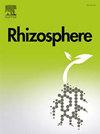Nitrogen deficiency drives fungal compositional shifts without functional changes in wheat rhizosphere
IF 3.5
3区 生物学
Q1 PLANT SCIENCES
引用次数: 0
Abstract
Nitrogen (N) deficiency reduces crop yield, but this effect may be mitigated by symbiotic interactions between crops and fungi. However, the response of wheat-fungal interactions to N deficiency remains unclear. We hypothesised that wheat cultivars with a higher reported nitrogen use efficiency (NUE), would induce shifts in the fungal community composition and functional profiles within the wheat rhizosphere to tolerate N deficiency. A glasshouse experiment was conducted to examine the effects of N deficiency on the rhizosphere fungal communities of wheat (Triticum aestivum L.) cultivars Gladius (low N-use efficiency) and Mace (high N-use efficiency). Plants were grown until the mid-anthesis stage in a Dermosol soil treated with either 0 (Low-N) or 90 kg N ha⁻1 (High-N). The rhizosphere fungal communities were characterised using quantitative PCR, ITS rRNA metabarcoding, and metagenomics. The abundance and diversity of the rhizosphere fungal community were not significantly influenced by N deficiency in either Mace or Gladius cultivars (P > 0.05). However, the fungal community composition showed significant variation across N treatments in Mace (P < 0.05), whereas no such effect was observed in Gladius (P > 0.05). Differential abundance analysis and fungal trait predictions indicated a reduction in fungal symbionts in both cultivars under N deficiency (P < 0.05). Metagenomic analysis demonstrated that fungal functional profiles remained unaffected by N deficiency (P > 0.05) but significantly differed between Mace and Gladius (P < 0.05). This study reveals intraspecific variation in rhizosphere fungal responses to N deficiency between Mace and Gladius. The metabarcoding and metagenomic data suggest functional redundancy within the fungal community, which may enhance wheat resilience under N-deficient conditions. These findings highlight the potential of using fungal community stability in developing biofertiliser products for sustainable agriculture.
缺氮导致小麦根际真菌组成变化,但没有功能改变
氮(N)缺乏降低作物产量,但这种影响可以通过作物与真菌之间的共生相互作用来减轻。然而,小麦-真菌相互作用对氮素缺乏的反应尚不清楚。我们假设氮利用效率(NUE)较高的小麦品种会引起小麦根际真菌群落组成和功能谱的变化,以适应氮缺乏。通过温室试验,研究了氮素缺乏对氮素利用效率低的小麦品种剑兰和氮素利用效率高的小麦品种根际真菌群落的影响。植物生长在用0(低氮)或90公斤氮毒血症(高氮)处理的真皮土壤中,直到开花中期。采用定量PCR、ITS rRNA元条形码和宏基因组学对根际真菌群落进行了表征。根际真菌群落的丰度和多样性均未受缺氮的显著影响(P >;0.05)。然而,真菌群落组成在不同氮素处理下表现出显著差异(P <;0.05),而在剑兰中没有观察到这种效应(P >;0.05)。差异丰度分析和真菌性状预测表明,在缺氮条件下,两个品种的真菌共生体数量减少(P <;0.05)。宏基因组分析表明,真菌功能谱不受缺氮影响(P >;0.05),但梅斯和剑兰之间差异显著(P <;0.05)。本研究揭示了毛茛和剑兰根际真菌对缺氮反应的种内差异。元条形码和宏基因组数据表明,真菌群落中存在功能冗余,这可能增强小麦在缺氮条件下的抗逆性。这些发现突出了利用真菌群落稳定性开发可持续农业生物肥料产品的潜力。
本文章由计算机程序翻译,如有差异,请以英文原文为准。
求助全文
约1分钟内获得全文
求助全文
来源期刊

Rhizosphere
Agricultural and Biological Sciences-Agronomy and Crop Science
CiteScore
5.70
自引率
8.10%
发文量
155
审稿时长
29 days
期刊介绍:
Rhizosphere aims to advance the frontier of our understanding of plant-soil interactions. Rhizosphere is a multidisciplinary journal that publishes research on the interactions between plant roots, soil organisms, nutrients, and water. Except carbon fixation by photosynthesis, plants obtain all other elements primarily from soil through roots.
We are beginning to understand how communications at the rhizosphere, with soil organisms and other plant species, affect root exudates and nutrient uptake. This rapidly evolving subject utilizes molecular biology and genomic tools, food web or community structure manipulations, high performance liquid chromatography, isotopic analysis, diverse spectroscopic analytics, tomography and other microscopy, complex statistical and modeling tools.
 求助内容:
求助内容: 应助结果提醒方式:
应助结果提醒方式:


